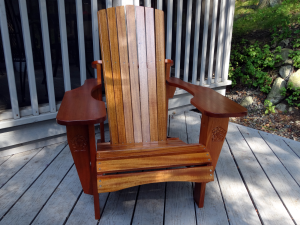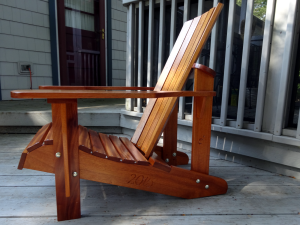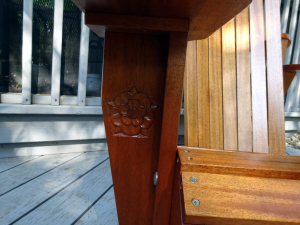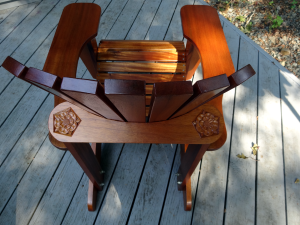Anyone should be able to build an Adirondack chair in a weekend right? Go get some wood, whack out the parts, screw it together, and slap on some paint. Right? Dang! Why build one at all? Down at the nearby garden center, they have some for sale at $39. Of course, those look like they were made from pallet wood and are flat in every dimension. They might not “sit” so well.
 This one started with some wood resawing back in April. I finally wrapped it up and moved it outside a couple of weeks ago.
This one started with some wood resawing back in April. I finally wrapped it up and moved it outside a couple of weeks ago.
Plans: I’m old enough to like things comfortable. Too many of these chairs have flat seats, flat backs, and look more like torture devices than chairs. I found one with curved seat and back. It’s a Fine Woodworking project. Oh look! It says “An Adirondack chair can be built in a day.” A companion article contains a video with a foolproof assembly sequence.  Plans are available for order, but by squinting (and imagining) a lot, I found enough detail in the low resolution online drawing. Who needs precise dimensions?
Plans are available for order, but by squinting (and imagining) a lot, I found enough detail in the low resolution online drawing. Who needs precise dimensions?
Lumber: 8/4 Mahogany (African) from Steve Wall. One 20 bd. ft. bundle will do if careful when resawing. 🙂
Process: No electrons (other than for lighting) were murdered in creating this chair.  Nor were numerous photos taken along the way. It’s a simple one-day project, right? I resawed the 8/4 stuff into boards of two thicknesses, approximating 1″ and 3/4″. From those, I hand sawed all of the parts. I used the saw and chisel technique on all curves, and then faired them with a spokeshave. I drilled the bolt holes with a simple brace and Jennings bit, then the bazillion screw holes with my eggbeater and Fuller bits which drill a tapered hole and countersink all in one go.
Nor were numerous photos taken along the way. It’s a simple one-day project, right? I resawed the 8/4 stuff into boards of two thicknesses, approximating 1″ and 3/4″. From those, I hand sawed all of the parts. I used the saw and chisel technique on all curves, and then faired them with a spokeshave. I drilled the bolt holes with a simple brace and Jennings bit, then the bazillion screw holes with my eggbeater and Fuller bits which drill a tapered hole and countersink all in one go.
Carvings:  Everything I make these days carries one or more carvings. Carving is what I enjoy most. The rest of woodworking is to make something that supports a carving. This chair has 4 Tudor Roses adapted from Mary May’s Tudor Rose lesson. It’s not that there’s any commonality between Tudor Roses and Adirondacks. It’s just that I like them. Add in a little bit of lettercarving with a year mark on one leg, and I’m delighted.
Everything I make these days carries one or more carvings. Carving is what I enjoy most. The rest of woodworking is to make something that supports a carving. This chair has 4 Tudor Roses adapted from Mary May’s Tudor Rose lesson. It’s not that there’s any commonality between Tudor Roses and Adirondacks. It’s just that I like them. Add in a little bit of lettercarving with a year mark on one leg, and I’m delighted.
Finish: Three coats of Minwax Helmsman Semi-gloss spar varnish. I used to hate brushing on a finish … and I have no place where I can use any sort of spray. This was one of the first finishing projects I actually enjoyed. Two reasons: getting the work at a comfortable height (saw benches) and using a very good Purdy 1″ soft bristle angle brush.
Once done, it “sits” well, very comfortable indeed.
That is a beautiful chair. Nice work!
Beautiful work Bob, really like your personal touch with the carving.
Well done, Bob. The carvings look spectacular and really add a lot of class to the chair. You should be very happy with it.
Bob, I see you got your lumber from Steve Wall, in Mayodan NC. They are right up the road from us and we get up there a couple of times a year to restock. I just want to encourage all your readers to check them out, and if possible to visit their yard. They have a fantastic selection of everything from local poplar, pine and oak to exotics from all over the world. I bought a pack of 100 board feet of cedar from them a couple of years ago and we are gradually working through it. I also found a straight, flat 12 foot pine board 20 inches wide which is stashed away for building a blanket chest some day. They have the selection and their prices are good too.
Fantastic Adirondack chair. The curves, carvings and bright finish really set it apart. What we can make for ourselves is so much better than what we can buy.
Now that is one fine Adirondack.
Very nice work. I like the carvings, especially the way the roses on the back brace are inset into hexagons. It makes for a very interesting contrast between the organic and the mechanical.
The look reminds me of the mahogany Adirodack chair I did (http://lumberjocks.com/projects/100916). Since I was steam-bending, I was able to run the seat slats parallel to the back slats, which allows you to dish the seat slightly from side to side and I think further improves the comfort of the chair. I purposely made my chair lightweight and was afraid to carve into the available surfaces, so I settled for an inlaid compass rose.
Your chair might share one problem with mine — too nice to leave out in the weather! 🙂
Very nice work Bob! It looks as if it is opening its arms to embrace and cradle those lucky enough to sit in it. What a very nice version of the ubiquitous adirondack chair.
Hi Bob…looks amazing, sir! What type of screw(s) did you use to attach the riser brackets? Those little triangular pieces towards the back of the arms. The FineWoodworking plans don’t include the specs. I’m sure I can “wing” it otherwise. Thank you!
Hello Brian,
I don’t remember what size screws I used, but suspect they are the same size used elsewhere in the chair, There’s not much reason for multiple sizes. I’m guessing #8 by 1 1/4″.
Enjoy!
Hi Bob…sorry for the delayed response I realized I don’t get notifications! I’m happy to say the chairs are fully assembled, and I did end up using two #8 1 1/2″ just to get a little more grab on those brackets. Picked up the spar varnish today as per your suggestion and look forward to seeing the grains at their best. Thanks again and take care.
We had some oak Adirondack chairs several decades ago that I tried to keep finished with the spar varnish of the time. It always ended up cracking and letting moisture in, with the oak developing dark stains. Sometimes, the cracking happened in less than one season.
While I dislike how some of the modern chemicals (of all sorts) have been reformulated, here is a case where the new stuff actually is much better. This finish shows NO adverse effects after the chair sitting outside for two years.
Hope you enjoy your new chair!